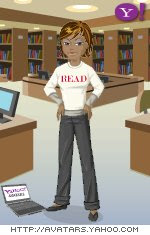In the library and classroom, we are often faced with the copyright challenges of when it is acceptable to copy something and how much of an item [book, website, music, etc] we can copy. Faced with declining budgets and little time, we are tempted to go ahead and make the copies. But with the advent of file sharing, downloading and RSS, we must acknowledge and teach the ethics of information gathering and sharing.
Creative Commons is a copyright license that allows us to choose to share our intellectual property. This course is designed under a Creative Commons license and is an example of how one can take a piece of information or a product and re-work it to make it fit your needs. By acknowledging the original authors, they have given permission for you to share.
Library 2.0 is a term used to describe a new set of concepts for developing and delivering library services. The name is an extension of Web 2.0 and shares many of its same philosophies and concepts including harnessing the user in both design and implementation of services, embracing constant change as a development cycle over the traditional notion of upgrades, and reworking library services to meet the users in their space. Many have argued that the notion of Library 2.0 is more than just a term used to describe concepts that merely revolve around the use of technology; it also a term that can be used to describe both physical and mindset changes that are occurring within libraries to make library spaces and services more user-centric and inviting. Others have asserted that libraries have always been 2.0: collaborative, customer friendly and welcoming. But no matter which side of the debate proponents fall, both sides agree that libraries of tomorrow, even five or ten years from now, will look substantially different from libraries today.
Discovery Exercise:
- Find where on the CSM Learning 2.0 blog where the authors have modified the original Learning2.0 course with permission and creative commons license from Helene Blowers.
- Read two or three of the perspectives on Library 2.0 from the list below. Create a blog post about your thoughts on any one of these.
- Library 2.0 - It's many things to many people. What does it mean to you? What does it mean for schools and libraries?
Discovery Resources:
- Creative Commons website
- Online copyright comic book developed by students at Duke University Law School
- “Wanna Work Together?” video about Creative Commons
- California Technology Assistance Project, Region IV cybersafety website. See Piracy.
- OCLC Next Space Newsletter – Web 2.0: Where will the next generation of the web it take libraries?
- The Horizon Report: educational technology trends in higher education. "Must" reading!
We hope you're enjoying all the exercises you've done so far. Keep having fun exploring and thinking about Web 2.0/CSMLearning 2.0
NEXT UP: #16 Wikis

